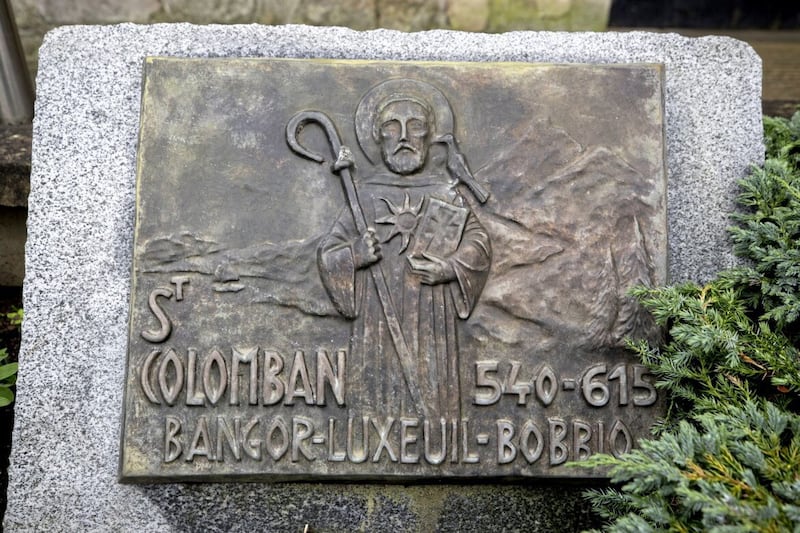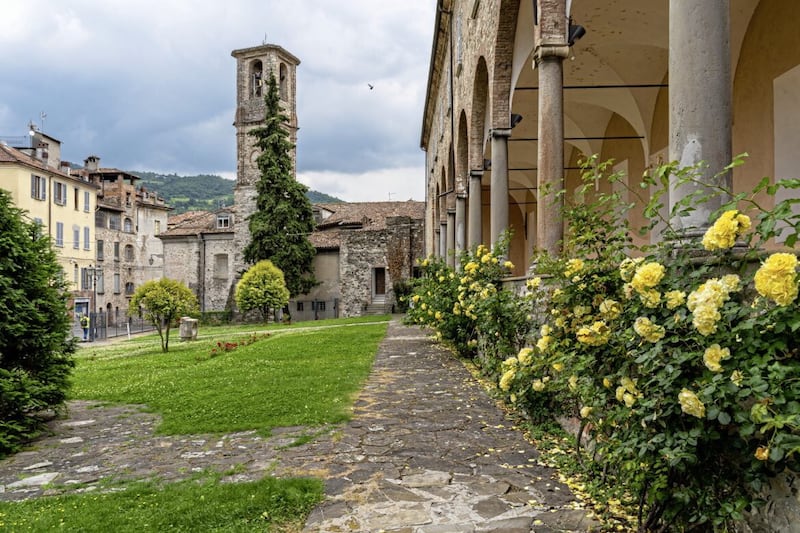Columbanus – the Latinised form of Columban, meaning 'the white dove' – was born south of Dublin in 543 and at an early age decided to devote his life to the service of Christ.
As a young man he headed north to Cleenish on Lough Erne in Co Fermanagh where, under Abbot Sinell, he began his training. Next, he travelled to Bangor – one of the foremost monastic centres of study and learning in medieval Ireland – where a monastic community with an austere lifestyle had been founded by Comgall.
In Bangor Columbanus served as a priest and master of the school, remaining there until around 591. Then, with the reluctant permission of Comgall, Columbanus answered the insistent call to pilgrimage for Christ and, with a group of 12 followers, travelled to continental Europe.
These men would go on to establish some of Europe's most influential Christian centres in present day France, Austria and Italy.
They travelled to Brittany in France and were received with favour by King Gunthram of Burgundy. They established a monastery at Annegray in the Vosges mountains. It grew in popularity and soon became overcrowded.
Consequently two new foundations were set up nearby at Luxeuil-les-Bains and Fontaines. Their austere rule of life reflected the Irish monastic tradition in which Columbanus had been formed; the disciplinary code for the monks was very harsh by modern standards.
Acting as an Abbot, Columbanus had established his monasteries without the authority of the French bishops and he clashed with the court on this and other issues. In 610 Columbanus was forced into exile and escorted right across France to Nantes by an armed guard to ensure he left the country.
Columbanus embarked on a ship but never reached Ireland. The master of the ship carrying him interpreted the continuous bad weather he encountered at the mouth of the River Loire as a divine sign that Columbanus was not to leave France.
Determined to continue his Christian mission in Europe, Columbanus travelled to Austria where he established a monastery at Bregenz on Lake Constance. Columbanus and Gall, a fellow monk, had a disagreement when Gall refused to follow Columbanus on his mission south of the Alps into Italy.
Afterwards Gall travelled on to Switzerland and as a result of his disobedience lived as a hermit for several years by the River Steinach. The town of St Gallen was established in the area after his death.

Columbanus, meanwhile, left Bregenz to walk over the Alps to Italy, having been instructed to go there in a dream. He stayed in Milan where he was kindly welcomed by King Agilulf and Queen Theudelinda. He preached and wrote significant work in Milan.
He was granted lands by the king for another secluded monastery which grew into the most famous of his foundations at Bobbio. By this time he was about 70 years old. According to tradition Columbanus died in a cave near Bobbio, choosing seclusion from the world to the end of his life. He died on November 23 615. His 'life' was written by the monk Jonas who entered Bobbio monastery a few years after the Columbanus's death.
Apart from Jonas's life of Columbanus, he also left a body of writings relevant to modern life in the 21st century.
Selected writings of Columbanus
:: "All of us are on the same path, to live in love"
:: "On the journey we engage with all and care for all"
:: "If you want to know the Creator look at creation"
Many manuscripts were produced in Bangor, the only surviving one being the Bangor Antiphonary, written around 690. It contains a poem of praise for the good rule of Bangor, a rule which inspired all of Columbanus's work. Today it is housed in the Ambrosian Library, Milan.
An international camino route, the Columban Way, is under development. The Columban Way is a European pilgrim route that traces the footsteps of Columbanus from Mount Leinster in Co Carlow through eight European countries – from Ireland, Britain, France, Germany, Liechtenstein, Switzerland, Austria to Italy. The final section of the Irish route, from Comber to Bangor, was launched in October 2021.
Read more:
- Council backs Columban Way support despite questions over trail being 'religious'
- Ireland's proud legacy of missionary outreach
- Campaigners for a Columban trail launch book mapping out route, urge greater support from councils, government agencies
For this year's Columbanus Festival, which runs from Friday to Sunday, the Friends of Columbanus have chosen the theme of 'bells'. The programme includes bell ringing, bell print workshops, a monastic bell lecture and a bell walk.
"Monastic bells played an important role in early medieval times to call the monks to prayer or warn of impending danger," explains Deborah Girvan, chair of the Friends of Columbanus Bangor.
"Inspired by the original Bangor Bell that is displayed in the North Down Museum, we chose the bell theme to build our programme around. We are delighted to welcome renowned expert Cormac Bourke, who will give a lecture entitled, 'Early Monastic Hand Bells Revisited'.
"We have teamed up with Seacourt Print Workshop in Bangor to deliver a series of workshops to learn how to print a unique, limited edition postcard of the Bangor Bell using letterpress.

"In addition, a bell ringing talk and practice session by the members of St Comgall's Church of Ireland, Hamilton Road, Bangor, will ring out the bells in honour of Columbanus.
"Along with all the other events and activities that we have planned, festival-goers will learn about our local monastic heritage and how bells have been an important part of worship right up to the present day."
:: The Columbanus Festival runs from Friday November 24 to Sunday November 26. To book an event, go to visitardsandnorthdown.com, drop into either Ards or Bangor Visitor Information Centres or call 028 9127 0069.
:: friendsofcolumbanusbangor.co.uk
:: Brigid Watson, of Sustainable Journeys Ireland, is offering guided tours in Co Down including the Bangor Bell walk and tours of St Patrick's Country. sustainablejourneysireland.com








